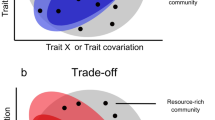Abstract
To study the impact of provenance selection of planting stock in (re)forestation and landscape plantings, the variation in bud and flower phenology, height increment and shrub morphology was examined within and between the local and non-local provenances of Crataegus monogyna in a provenance trial. Seven Belgian provenances were included, five in Flanders and two in Wallonia, completed with three commercial provenances originating from Italy, Hungary and the United Kingdom. A completely randomized design (single tree plots) was adopted. Data were processed using mixed modelling techniques. South European provenances flushed up to 7 days earlier than the Flemish provenances, whereas the Walloon provenances flushed 4 days later. Compared to the Flemish provenances, Southern provenances and Walloon provenances flowered 4 days earlier and 2 days later respectively. Height increment and shrub morphology did not vary significantly between the Belgian and commercial provenances. Bud burst varied less than flowering among the Flemish and the Walloon provenances. This possibly indicates a higher selection pressure on bud burst than on flowering. The higher time lag between the different provenances for bud burst in comparison to flowering indicates a stronger plastic response for the latter. The results point out the importance of bud burst as an indicator of local adaptation to geo-climatologic components. Finally, it appeared that old hedges are likely to be good sources of locally adapted seed.







Similar content being viewed by others
References
Alberto F, Bouffier L, Louvet JM, Lamy Delzon S, Kremer A (2011) Adaptive responses for seed and leaf phenology in natural populations of sessile oak along an altitudinal gradient. J Evol Biol 24:1442–1454
Anonymous (2003) Besluit van de Vlaamse regering betreffende de procedure tot erkenning van bosbouwkundig uitgangsmateriaal en het in de handel brengen van bosbouwkundig teeltmateriaal. Belgian Law Gazette 11:54793–54824
Christensen RHB (2013) ordinal: Regression models for ordinal data. In: R package version 2013. pp 10–31. http://www.cran.r-project.org/package=ordinal/
Chuine I, Beaubien E (2001) Phenology is a major determinant of tree species range. Ecol Lett 4:500–510
Chuine I, Cour P (1999) Climatic determinants of budburst seasonality of temperate-zone trees. New Phytol 143:339–349
Council of the European Union (2000) Council Directive 1999/105/EC of 22 December 1999 on the marketing of forest reproductive material. Off J Eur Comm L11:17–40
Ducousso A, Guyon JP, Kremer A (1996) Latitudinal and altitudinal variation of bud burst in western populations of sessile oak (Quercus petraea (Matt.) Liebl.). Ann Forest Sci 53:775–782
Edmands S (2007) Between a rock and a hard place: evaluating the relative risks of inbreeding and outbreeding for conservation and management. Molec Ecol 16:463–475
Hubert J, Cottrell J (2007) The role of forest genetic resources in helping British forests respond to climate change. Forestry Commission Scotland, Edinburgh
Jones AT, Hayes MJ, Sackville Hamilton N (2001) The effect of provenance on the performance of Crataegus monogyna in hedges. J Appl Ecol 38:952–962
Kleinschmit JRG, Kownatzki D, Gegorius HR (2004) Adaptational characteristics of autochthonous populations – consequences for provenance delineation. Forest Ecol Manag 197:213–224
Krauss LS, He TH (2006) Rapid genetic identification of local provenance seed collection zones for ecological restoration and biodiversity conservation. J Nature Conserv 14:190–199
Laikre L, Schwartz MK, Waples RS, Ryman N (2010) Compromising genetic diversity in the wild: unmonitored large-scale release of plants and animals. Trends Ecol Evol 25:520–529
McKay JK, Christian CE, Harrison S, Rice KJ (2005) “How local is local?”—a review of practical and conceptual issues in the genetics of restoration. Restor Ecol 13:432–440
McKown AD, Guy RD, Klapste J, Geraldes A, Friedmann M, Cronk QCB, El-Kassaby YA, Mansfield SH, Douglas CJ (2014) Geographical and environmental gradients shape phenotypic trait variation and genetic structure in Populus trichocarpa. New Phytol 201:1263–1276
Olson MS, Levsen N, Soolanayakanahally RY, Guy RD, Schroeder WR, Keller SR, Tiffin P (2012) The adaptive potential of Populus balsamifera L. to phenology requirements in a warmer global climate. Molec Ecol 22:1214–1230
Pinheiro J, Bates D, DebRoy S, Sarkar D, the R Development Core Team (2013) nlme: Linear and Nonlinear Mixed Effects Models. In: R Core Team, R package version 3.1-113. R Foundation for Statistical Computing, Vienna
Robson TM, Alia R, Bozic G, Clark J, Forsteuter M, Gomory D, Liesebach M, Mertens P, Rasztovits E, Zitova M, von Wuhlisch G (2011) The timing of leaf flush in European beech (Fagus sylvatica L.) saplings. In: Genetic Resources of European Beech (Fagus sylvatica L.) for Sustainable Forestry, Proceedings of the COST E52 Final Meeting, Serie Forestal 22:61–80
Savolainen O, Pyhäjärvi T, Knürr T (2007) Gene flow and local adaptation in trees. Annu Rev Ecol Evol Syst 38:595–619
Soolanayakanahally RY, Guy RD, Silim SN, Song M (2013) Timing of photoperiodic competency causes phenological mismatch in balsam poplar (Populus balsamifera L.). Pl Cell Environm 36:116–127
R Core Team (2013) R: a language and environment for statistical computing. R Foundation for Statistical Computing, Vienna. http://www.R-project.org/
Vander Mijnsbrugge K, Cox K, Van Slycken J (2005) Conservation approaches for autochthonous woody plants in Flanders. Silvae Genet 54:197–205
Vander Mijnsbrugge K, Bischoff A, Smith B (2010) A question of origin: where and how to collect seed for ecological restoration. Basic Appl Ecol 11:300–311
Acknowledgments
We are grateful to Leander Depypere for the collection of the Flemish Crataegus seeds and to André Meersman for the height measurements in the provenance trial. Also, we like to thank Willem Stevens and Yves Verhaeghe for planting and maintaining the provenance trial. In addition, we are most grateful to Stefaan Moreels for his greenhouse skills and his indispensable technical and supportive assistance during the whole study.
Author information
Authors and Affiliations
Corresponding author
Rights and permissions
About this article
Cite this article
Vander Mijnsbrugge, K., Onkelinx, T. & De Cuyper, B. Variation in bud burst and flower opening responses of local versus non-local provenances of hawthorn (Crataegus monogyna Jacq.) in Belgium. Plant Syst Evol 301, 1171–1179 (2015). https://doi.org/10.1007/s00606-014-1141-6
Received:
Accepted:
Published:
Issue Date:
DOI: https://doi.org/10.1007/s00606-014-1141-6




